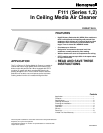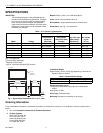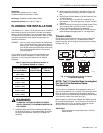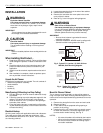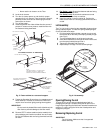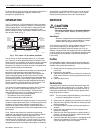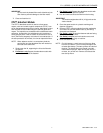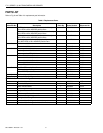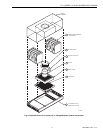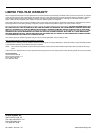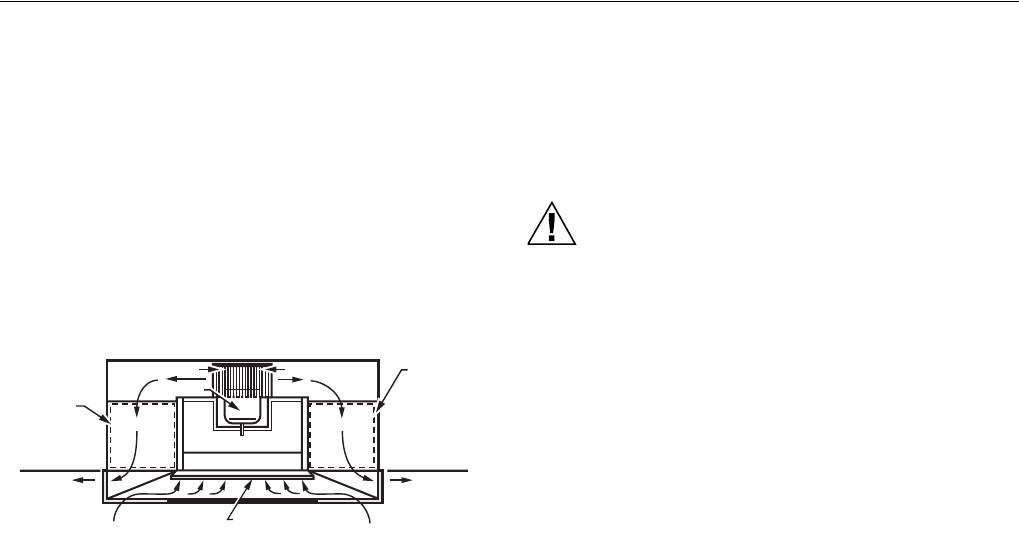
F111 (SERIES 1,2) IN CEILING MEDIA AIR CLEANER
68-0198EF-4 Revised 11-07 6
To remove the lid, swing it into the open position. Move the lid
to the side to disengage the hinge pins. Reverse the
procedure to replace the lid.
OPERATION
The F111 (series 1,2) in Ceiling Media Air Cleaner has been
engineered to improve indoor air quality for commercial and
industrial applications. The filters are the most practical and
effective filtering system for removing atmospheric dust,
pollens, bacteria, viruses, mold spores, smoke, fumes, mists
and aerosols. Refer to Fig. 7.
Fig. 7. F111 (series 1,2) air cleaner operation.
The air cleaner is either operating (power on) or off (power
off). There are no other operational options available. Even
when the area is unoccupied, the air cleaner can be operated
continuously to prevent buildup of airborne contaminants.
Operate the air cleaner only when the area is occupied when
specific activities produce contaminants.
The CPZ™ sorbent module has the ability to collect and hold
gas-phase compounds and vapors typically found in
commercial and light industrial facilities. These gases and
vapors frequently appear as odors that, at times, can be
annoying and irritating. The modules become saturated after
collecting 25% to 50% of their weight in gaseous odors. The
quantity of CPZ™ material provides adequate dwell time to
ensure up to 95% collection efficiency in the first pass. This
also provides a long maintenance-free service life.
The minimum recommended air exchange rate is 2.5 times
per hour. In a heavily contaminated area, up to 15 air
exchanges per hour can be necessary. The factors that
determine what the rate of air exchange should be are:
• generation rates of the various pollutants;
• concentration level of the pollutants;
• desired contamination reduction level.
Airborne contaminants will always be present in the air where
contaminant generations take place. Air cleaning systems and
ventilators do not eliminate airborne contaminants, they
reduce the excessive accumulation of the contaminants. To
eliminate the contamination, the source of contamination must
be removed.
Local, Federal and professional ventilation engineering
standards and codes prescribe minimum ventilation rates to
dilute air contamination in specific applications. The
ventilation rates usually assume the injection of outdoor air
measured as air exchange rate. The use of the F111 (series
1,2) air cleaner to comply with ventilation requirements is an
acceptable alternative to ventilation with outdoor air. However,
at least 20% of a specified ventilation rate or code must be
derived from outdoor air. The F111 (series 1,2) air cleaner
filtered and recirculated air can be the remaining 80%.
SERVICE
CAUTION
Electrical Hazard.
Can cause personal injury or equipment damage.
Turn off power before installing or servicing the air
cleaner.
IMPORTANT
Be sure to change filters as recommended to prevent
reduced airflow in the air cleaner.Stand on a stable
platform when working with the air cleaner.
The useful life of the CPZ™ sorbent modules may vary from 4
to 24 months, depending on the application. In most
applications, the sorbent media life ranges from 12 to 18
months. The particle filter life ranges from 6 to 24 months with
12 to 24 months as an average. The modules and filters need
to be changed more frequently in facilities that operate 24
hours a day.
Prefilter
The disposable prefilter collects large dust particulates and
lint- type airborne fibers. Check the filter every two weeks to
determine the replacement frequency:
1. Slowly open the lid, supporting the lid so the filters do
not fall out.
2. Remove the dirty prefilter.
3. Install the new prefilter in the air cleaner lid. Position the
metal screen mesh so it is facing upward when the lid is
closed.
4. Close and latch the lid.
Particle Filter
The particle filter collects particulates that pass through the
prefilter. The filter life is typically from 1 to 2 years. There is
decreased air quality and a pulsing sound when the filter is
loading the contaminants. The filter must be replaced when
the pulsing sound is noticed.
NOTE: The filter must be replaced. Washing, vacuuming or
reverse air blasting does not clean it.
1. Slowly open lid, supporting it so the filters do not fall out.
2. Open the securing strips and with both hands and slide
the filter toward you.
3. Place spent filter in a plastic trash bag and dispose of
properly.
4. Inspect the motor brackets for loose fasteners and
tighten as necessary.
5. Install the new filter. Note direction of airflow arrows, if
present. If arrows are not present, install the filter with
the fasteners facing downward.
6. Fasten the filter tabs. Be sure there is a snapping sound
when they are fastened. The tabs are commercial
Velcro and require more force to fasten.
M12651A
CEILING LINE
CLEAN AIR
DISCHARGE
CEILING LINE
CLEAN AIR
DISCHARGE
PARTICLE FILTER
PREFILTER
AIR IN
AIR IN
INTAKE
BLOWER
MOTOR
AIR VENTS
CPZ™
SORBENT
FILTER
MODULE
CPZ™
SORBENT
FILTER
MODULE



